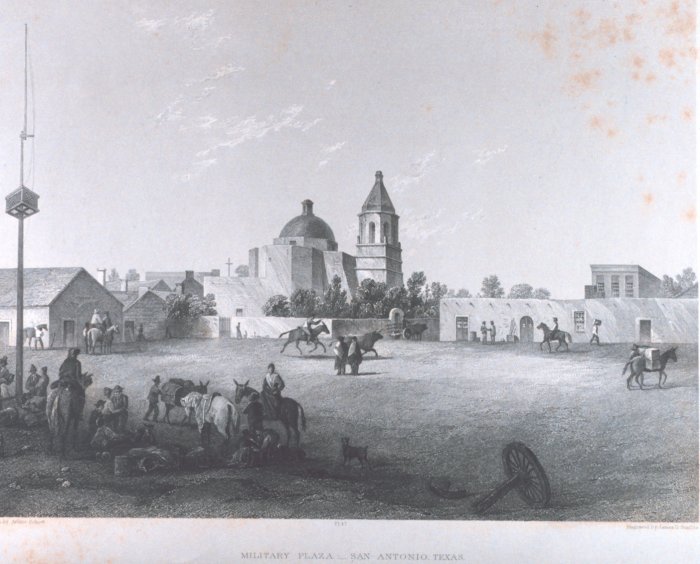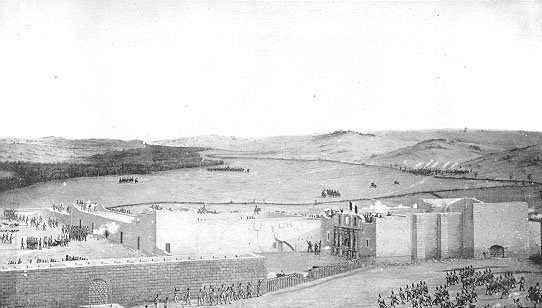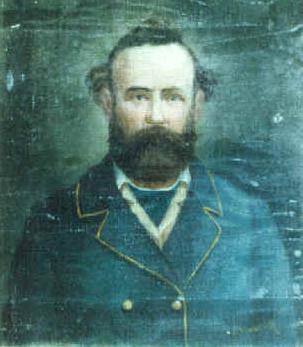|
Colorado Smith
John William Smith (November 4, 1792 – January 12, 1845) (born William John Smith in Virginia) was a Texas political figure, the first mayor of San Antonio under the Republic of Texas and the first mayor of San Antonio under the state of Texas. He supported and served Texas during the struggle for Texas Independence. Early life Smith was born as the second son of John and Isabel Smith. He grew up in Ralls County, Missouri after moving from his birth state of Virginia, and received an expensive education. He married Harriet Stone in Hannibal, Missouri sometime between 1821 and 1822. They had three known children, Samuel, Mary Elizabeth and Lucinda. His first elected position was in 1822 as Sheriff of Ralls County and State and County tax Collector. He resigned from the post in 1826 to move to Texas following the birth of his third child. His wife refused to accompany him and filed for divorce. She ultimately came to Texas with her second husband. Move to San Antonio Smith m ... [...More Info...] [...Related Items...] OR: [Wikipedia] [Google] [Baidu] |
Mayor Of San Antonio
The following is a list of mayors of San Antonio, Texas. San Antonio operates under a council–manager form of government.Kriston CappsWhy Julián Castro's Record as Mayor of San Antonio Doesn't Necessarily Tell Us Much About His Future at HUD ''CityLab'' (May 19, 2014).Sharon NavarroThe Latino Mayors: San Antonio Politics and Policies Research Report No. 52, April 2015, Julian Samora Research Institute, Michigan State University, p. 2. While the mayor presides over meetings of the City Council and is paid $3,000 more than other members of the Council, the mayor does not wield executive authority or veto power. Rather, the mayor has one vote (of 11) on the city council, and the city manager, appointed by the City Council, has executive power (the city charter gives the manager the responsibility to "execute the laws and administer the government of the city"). However, the mayor does have additional ceremonial responsibilities, such as issuing proclamations. Additionally, the may ... [...More Info...] [...Related Items...] OR: [Wikipedia] [Google] [Baidu] |
Byrd Lockhart
Byrd Lockhart (1782–1839), was a 19th-century American surveyor, Alamo defender, courier, and Texian officer during the Texas Revolution. Early life and family Lockhart was born in Virginia in 1782. At age 32, Byrd Lockhart was known to be a surveyor in Madison County, Illinois. He moved to Texas from Missouri with his mother, sister, and two children. He was already a widower when he settled in Green DeWitt's colony on March 20, 1826.Groneman, ''Alamo Defenders'', p. 72. Career in Texas Lockhart was appointed deputy surveyor to James Kerr on December 12, 1826, and surveyed the lands of DeWitt Colony around Gonzales. In January, he headed a meeting denouncing the Fredonian Rebellion and pledging loyalty to the Mexican government. In April, he was put in charge of defense in Gonzales, using a row of blockhouses that served as protection against Indians. Later in 1827, he pioneered construction of roads from Bexar to Gonzales and from the Lavaca River right bank to the Matagord ... [...More Info...] [...Related Items...] OR: [Wikipedia] [Google] [Baidu] |
Washington-on-the-Brazos
Washington-on-the-Brazos is an unincorporated community along the Brazos River in Washington County, Texas, United States. The town is best known for being the site of the Convention of 1836 and the signing of the Texas Declaration of Independence. The town is named for Washington, Georgia, itself named for George Washington. It is officially known as just "Washington," but after the Civil War came to be known as "Washington-on-the-Brazos" to distinguish the settlement from "Washington-on-the- Potomac," Washington, DC. History Washington was founded in 1833 by John W. Hall, one of the Old Three Hundred settlers, on land he had been given two years before by his father-in-law Andrew Robinson. It was located at a ferry crossing over the Brazos River on the La Bahia Road that dated from 1821. As the town grew, most settlers were immigrants from the Southern United States, in what was then Mexican Texas. Because of its location on the Brazos River and near major roads, Washington ... [...More Info...] [...Related Items...] OR: [Wikipedia] [Google] [Baidu] |
William B
William is a male given name of Germanic origin.Hanks, Hardcastle and Hodges, ''Oxford Dictionary of First Names'', Oxford University Press, 2nd edition, , p. 276. It became very popular in the English language after the Norman conquest of England in 1066,All Things William"Meaning & Origin of the Name"/ref> and remained so throughout the Middle Ages and into the modern era. It is sometimes abbreviated "Wm." Shortened familiar versions in English include Will, Wills, Willy, Willie, Bill, and Billy. A common Irish form is Liam. Scottish diminutives include Wull, Willie or Wullie (as in Oor Wullie or the play ''Douglas''). Female forms are Willa, Willemina, Wilma and Wilhelmina. Etymology William is related to the given name ''Wilhelm'' (cf. Proto-Germanic ᚹᛁᛚᛃᚨᚺᛖᛚᛗᚨᛉ, ''*Wiljahelmaz'' > German ''Wilhelm'' and Old Norse ᚢᛁᛚᛋᛅᚼᛅᛚᛘᛅᛋ, ''Vilhjálmr''). By regular sound changes, the native, inherited English form of the name should b ... [...More Info...] [...Related Items...] OR: [Wikipedia] [Google] [Baidu] |
Battle Of The Alamo
The Battle of the Alamo (February 23 – March 6, 1836) was a pivotal event in the Texas Revolution. Following a 13-day siege, Mexican troops under President General Antonio López de Santa Anna reclaimed the Alamo Mission near San Antonio de Béxar (modern-day San Antonio, Texas, United States), killing most of the occupants inside. Santa Anna's refusal to take prisoners during the battle inspired many Texians and Tejanos to join the Texian Army. Motivated by a desire for revenge, as well as their written desire to preserve a border open to immigration and the importation and practice of slavery, the Texians defeated the Mexican Army at the Battle of San Jacinto, on April 21, 1836, ending the rebellion in favor of the newly formed Republic of Texas. Several months previously, Texians, who were primarily recent immigrants from USA, had killed or driven all Mexican troops out of Mexican Texas. About 100 Texians were then garrisoned at the Alamo. The Texian force grew sl ... [...More Info...] [...Related Items...] OR: [Wikipedia] [Google] [Baidu] |
Gonzales, Texas
Gonzales is a city in Gonzales County, Texas, United States. It is the county seat. The population was 7,165 at the 2020 census. The "Come and Take It" flag in the War for Texas Independence from Mexico originated in Gonzales. Its economy is enhanced through lodging oil field workers from the nearby Eagle Ford Shale. It was the site of the first battle of the Texas Revolution. History Gonzales is one of the earliest Anglo-American settlements in Texas, the first west of the Colorado River. It was established by Empresario Green DeWitt as the capital of his colony in August 1825. DeWitt named the community for Rafael Gonzáles, governor of Coahuila y Tejas. Informally, the community was known as the DeWitt Colony. The original settlement (located where Highway 90-A crosses Kerr Creek) was abandoned in 1826 after two Indian attacks. It was rebuilt nearby in 1827. The town remains today as it was originally surveyed. Gonzales is referred to as the " Lexington of Texas" because i ... [...More Info...] [...Related Items...] OR: [Wikipedia] [Google] [Baidu] |
Siege Of The Alamo
The siege of the Alamo (February 23 – March 6, 1836) was the first thirteen days of the Battle of the Alamo. On February 23, Mexican troops under General Antonio Lopez de Santa Anna entered San Antonio de Bexar, Texas, and surrounded the Alamo Mission. The Alamo was defended by a small force of Texians and Tejanos, led by William Barrett Travis and James Bowie, and included Davy Crockett. Before beginning his assault on the Alamo, Santa Anna offered them one last chance to surrender. Travis replied by opening fire on the Mexican forces and, in doing so, effectively sealed their fate.Fowler (2007), p.166. The siege ended when the Mexican Army launched an early-morning assault on March 6. Almost all of the defenders were killed, although several civilians survived. Background In 1835, as the Mexican government began to shift away from a federalist model, violence erupted in several Mexican states, including the border region Mexican Texas.Todish ''et al.'' (1998), p. ... [...More Info...] [...Related Items...] OR: [Wikipedia] [Google] [Baidu] |
Siege Of Bexar
A siege is a military blockade of a city, or fortress, with the intent of conquering by attrition, or a well-prepared assault. This derives from la, sedere, lit=to sit. Siege warfare is a form of constant, low-intensity conflict characterized by one party holding a strong, static, defensive position. Consequently, an opportunity for negotiation between combatants is common, as proximity and fluctuating advantage can encourage diplomacy. The art of conducting and resisting sieges is called siege warfare, siegecraft, or poliorcetics. A siege occurs when an attacker encounters a city or fortress that cannot be easily taken by a quick assault, and which refuses to surrender. Sieges involve surrounding the target to block the provision of supplies and the reinforcement or escape of troops (a tactic known as " investment"). This is typically coupled with attempts to reduce the fortifications by means of siege engines, artillery bombardment, mining (also known as sapping), or the us ... [...More Info...] [...Related Items...] OR: [Wikipedia] [Google] [Baidu] |
Samuel Maverick
Samuel Augustus Maverick (July 23, 1803 – September 2, 1870) was a Texas lawyer, politician, land baron and signer of the Texas Declaration of Independence. His name is the source of the term "maverick," first cited in 1867, which means "independently minded." Various accounts of the origins of the term held that Maverick came to be considered independently minded by his fellow ranchers because he refused to brand his cattle, though it might have instead reflected a lack of interest in ranching. Unbranded cattle which were not part of the herd came to be labeled "mavericks". He was the grandfather of Texas politician Maury Maverick, who coined the term gobbledygook (1944). Early years Samuel Augustus Maverick was the oldest son of Samuel Maverick, a Charleston businessman, and his wife Elizabeth Anderson.Marks (1989), p. 4. His Maverick ancestors had arrived in the New World in 1624, before emigrating to Barbados and later to Charleston.Marks (1989), p. 5. After his paternal ... [...More Info...] [...Related Items...] OR: [Wikipedia] [Google] [Baidu] |
Domingo Ugartechea
Domingo de Ugartechea (c. 1794 – 24 May 1839) was a 19th-century Mexican Army officer for the Republic of Mexico. Biography Early years Domingo de Ugartechea served for José Joaquín de Arredondo in 1813. Ugartechea as well as Antonio López de Santa Anna were cadets during the suppression of the Gutiérrez–Magee Expedition, and at the Battle of Medina. In June 1832, Ugartechea commanded 125 men at the fort at Velasco, Texas; he attempted to employ his artillery to prevent rebelling Texas colonists under John Austin from taking cannon from Brazoria to Anahuac at the time of the Anahuac disturbances. Although defeated by the Texans in the eleven-hour Battle of Velasco, Ugartechea was permitted to evacuate the fort. In 1835 Ugartechea was military commandant of Coahuila and Texas in command of the forces at Presidio San Antonio de Béxar, all the while struggling with deficiencies in funding, supplies, and manpower. Although 200 men appeared on his rolls, only ... [...More Info...] [...Related Items...] OR: [Wikipedia] [Google] [Baidu] |
Canary Islands
The Canary Islands (; es, Canarias, ), also known informally as the Canaries, are a Spanish autonomous community and archipelago in the Atlantic Ocean, in Macaronesia. At their closest point to the African mainland, they are west of Morocco. They are the southernmost of the autonomous communities of Spain. The islands have a population of 2.2 million people and they are the most populous special territory of the European Union. The seven main islands are (from largest to smallest in area) Tenerife, Fuerteventura, Gran Canaria, Lanzarote, La Palma, La Gomera, and El Hierro. The archipelago includes many smaller islands and islets, including La Graciosa, Alegranza, Isla de Lobos, Montaña Clara, Roque del Oeste, and Roque del Este. It also includes a number of rocks, including those of Salmor, Fasnia, Bonanza, Garachico, and Anaga. In ancient times, the island chain was often referred to as "the Fortunate Isles". The Canary Islands are the southernmost region of Spain, and ... [...More Info...] [...Related Items...] OR: [Wikipedia] [Google] [Baidu] |
Juan Curbelo (Tejano Settler)
Juan Curbelo (1680 - 1760) was a Spanish politician who served as the sixth and eighth mayor of San Antonio, Texas in 1737 and 1739. His family arrived in San Antonio from the Canary Islands in 1731 with other Canarian families to populate the region. Biography Juan Curbelo was born in 1680 in Lanzarote, Canary Islands, Spain and was son of Domingo Curbelo y María Martín Enríquez. He arrived in San Antonio, San Fernando de Béxar, Texas (present-day San Antonio) in 1731. In 1737 and 1739, he served one-year terms as mayor of the community. He married Gracia Perdomo y Umpienres.Juan Curbelo profile Bexargenealogy.com; accessed April 18, 2018. Juan Curbelo and his wife had five children: José, Juan Francisco (born in La Palma, Canary Islands), Mariana (born in Lanzarote), Juana and María Curbelo. [...More Info...] [...Related Items...] OR: [Wikipedia] [Google] [Baidu] |





